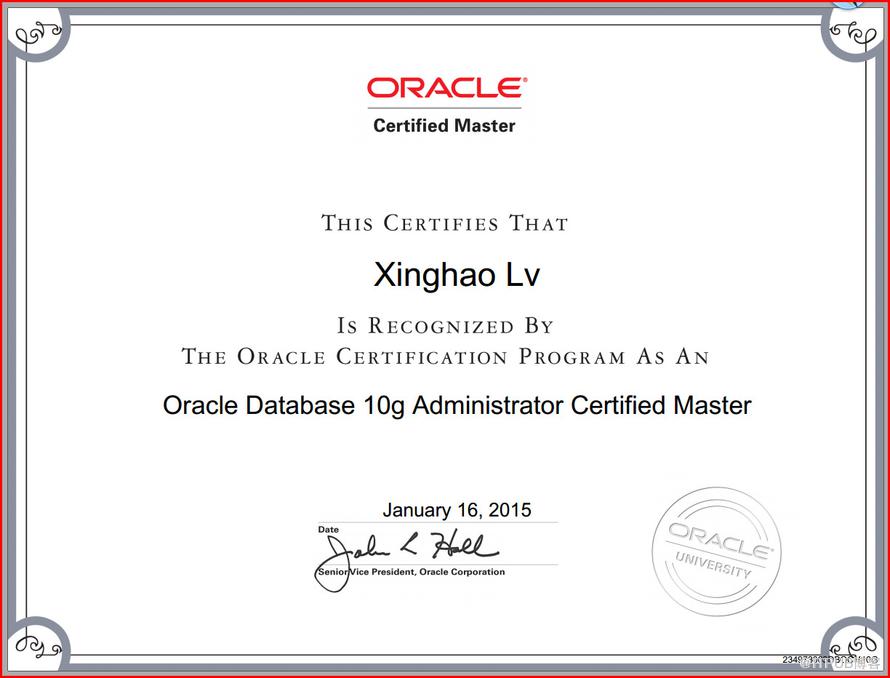Oracle Database 10g Administrator Certified Master Exam
Platform
Oracle Database 10g Enterprise Edition Release 10.2.0.2.0
Oracle Enterprise Manager 10g Grid Control Release 10.2.0.1.1
Operating System:
Oracle Enterprise Linux 5 Update 4 (OEL 5 Update 4)
Notes about the exam
Exam participants work through eight skillsets that are based on exam objectives.
Approximately 40% of the tasks must be performed using CLI.
Approximately 40% of the tasks can be performed using either CLI or OEM
The remaining tasks need to be performed using various other tools like Oracle Universal Installer and Database Configuration Assistant.
Server Configuration
Create the database
Determine and set sizing parameters for database structures
Create and manage temporary, permanent, and undo tablespaces
Stripe data files across multiple physical devices and locations
Configure the database environment to support optimal data access performance
Create and manage database configuration files
Create and manage bigfile tablespaces
Create and manage multiple network configuration files
Create and configure a listener
Configure the database instance to support shared server connections
Set up network tracing
Manage Oracle network processes (the Listener Control utility)
Configure the network environment to allow connections to multiple databases
Use configurationless connections
Enterprise Manager Grid Control
Install the Enterprise Manager Grid Control software
Configure the Enterprise Manager repository
Create Enterprise Manager Grid Control users
Use Enterprise Manager to modify a database configuration
Configure Enterprise Manager to modify a database availability
Create and manage jobs
Create and monitor alerts
Create notifications
Implement Grid Control and Database Control
Choose the appropriate tablespace type for the intended use
Create Scheduler jobs
Create schedules
Assign jobs to windows
Create programs
Create job classes
Install the Enterprise Manager Grid Control infrastructure
Deploy Enterprise Manager Grid Control agents
Configure Grid Control for business requirements
Managing Database Availability
Create a recovery catalog database
Configure Recovery Manager
Use Recovery Manager to perform database backups
Use Recover Manager to perform complete database restore and recovery operations
Set Flashback Database parameters
Monitor Flashback Database logs and statistics
Perform a Flashback Database operation
Configure a flash recovery area
Data Management
Implement fine-grained auditing
Create a secure application role
Grant specific privileges for a Flashback Query
Set parameters for retaining undo
Implement fine-grained access control
Create and manage contexts
Use SQL*Loader
Implement transportable tablespaces between homogeneous and heterogeneous systems (using different methods of moving files)
Choose the appropriate partition method (range, hash, list, and composite)
Choose the appropriate partition key
Choose appropriate indexing methods (local, global, prefixed, and nonprefixed)
Perform partition maintenance operations
Maintain indexes on a partitioned table
Create and manage LOB segments
Apply parallelism appropriately
Tune memory for parallel operations
Set parallel parameters
Data Warehouse Management
Create external tables (Data Loader and Data Pump drivers)
Implement Data Pump export and import jobs for data transfer
Implement Data Pump to and from remote databases
Implement Replication/Streams
Configure and manage master replication
Configure and manage distributed materialized views
Configure and manage Streams for replication
Performance Management
Install Statspack
Adjust the default interval for statistics collection
Customize the events that are monitored
Use ADDM to analyze statistics and to identify performance bottlenecks and fix them
Implement automatic shared memory management
Tune memory using manual memory management
Monitor and tune SGA areas that are not automatically tuned
Implement automatic SQL execution memory management
Tune the PGA using work area size parameters
Use the PGA Advisor
Create a Database Resource Manager plan with directives (active session count, max execution time)
Create consumer groups
Configure consumer group mappings
Manage Services
Create and manage objects to accommodate different data access methods (schema tuning)
Use the SQL Tuning Advisor
Use the SQL Access Advisor
Gather Optimizer statistics
Interpret execution plan
Use SQL tuning tools and features
Real Application Clusters
Install Oracle Clusterware
Install the Oracle Database 10g software
Implement ASM failure groups
Create and manage as ASM instance
Create and manage ASM disk groups
Configure ASM for the shared disks, and create a clustered database
Configure archiving
Configure Services with a preferred instance and an available instance
Data Guard
Use Data Guard Manager and DGMGRL
Create and utilize a physical standby database
Create and utilize a logical standby database
Set up log transport services for various levels or protection
Configure the network environment to allow communication between the standby database and the primary database
Open the physical standby database in a "ready-only" state
Perform a switchover operation and a failover operation
Implement Data Guard

吕星昊




















 165
165











 被折叠的 条评论
为什么被折叠?
被折叠的 条评论
为什么被折叠?








